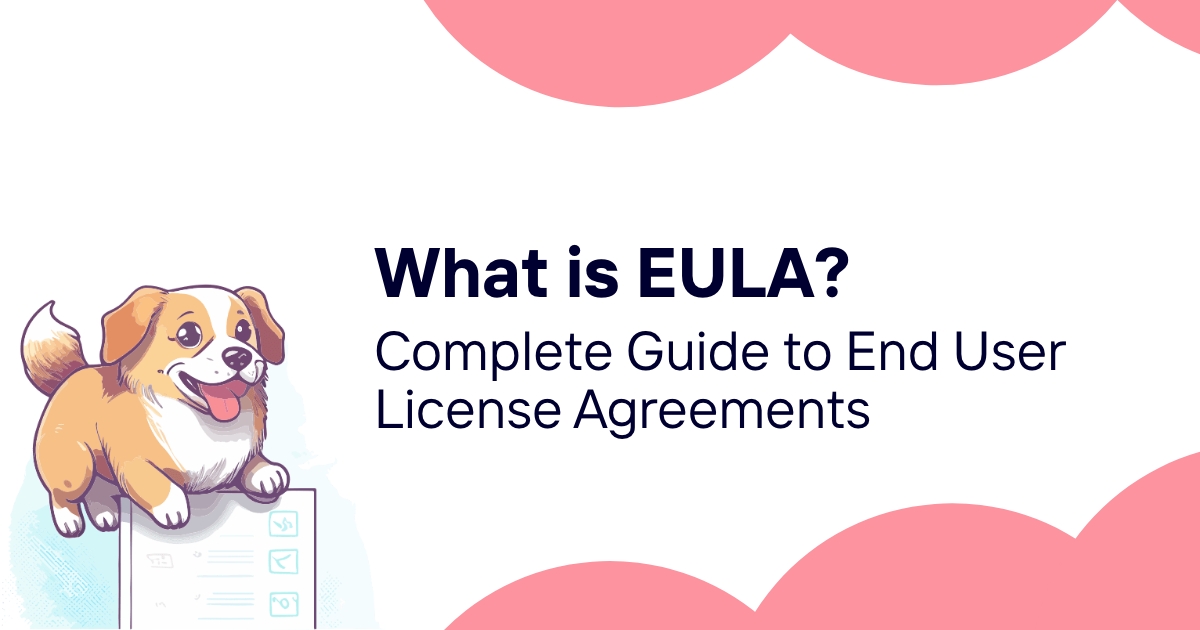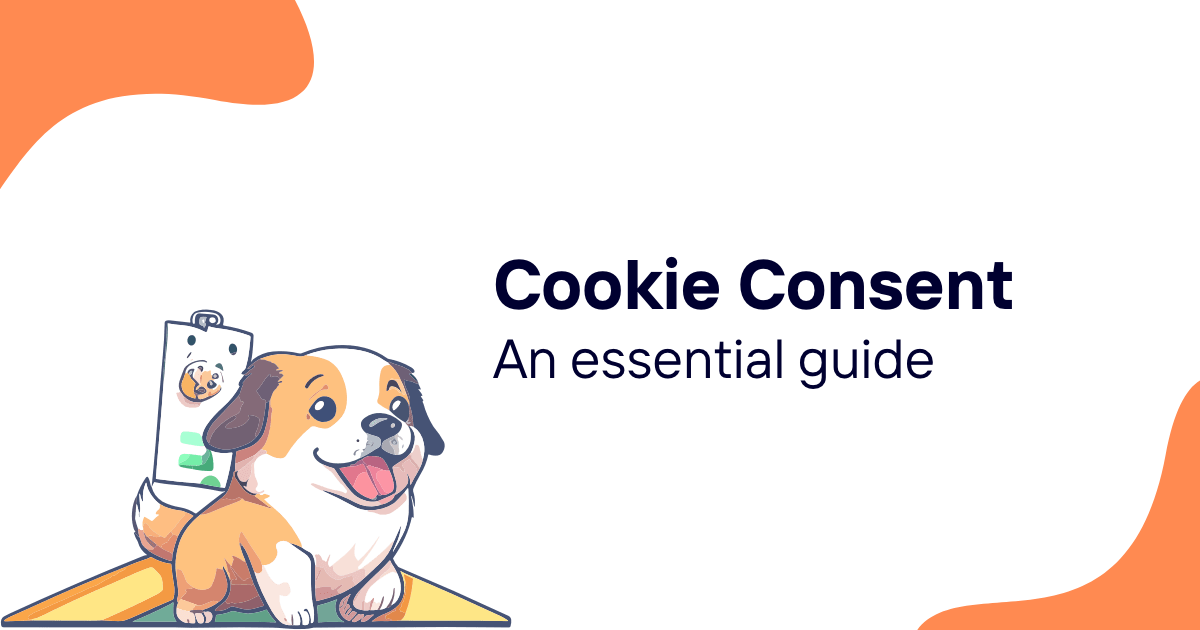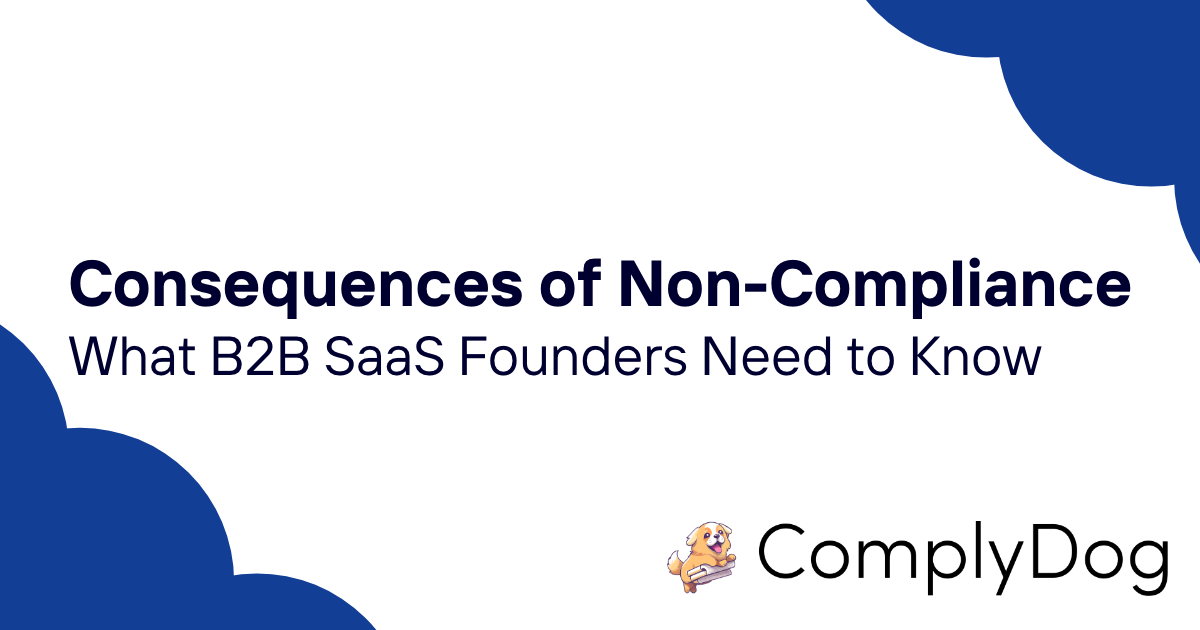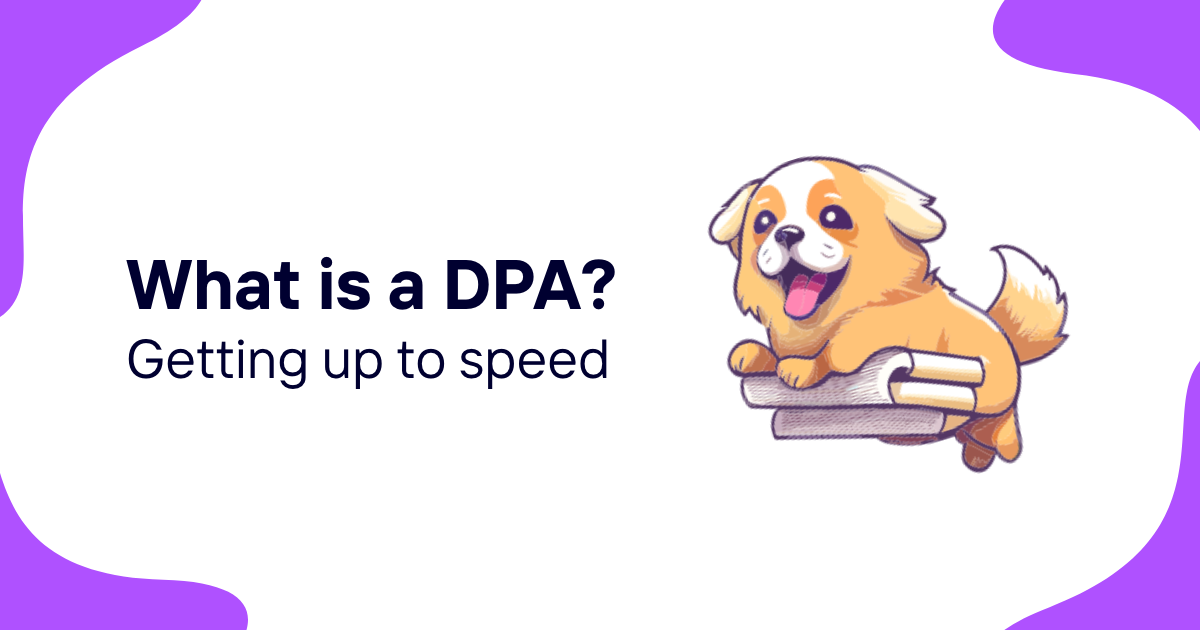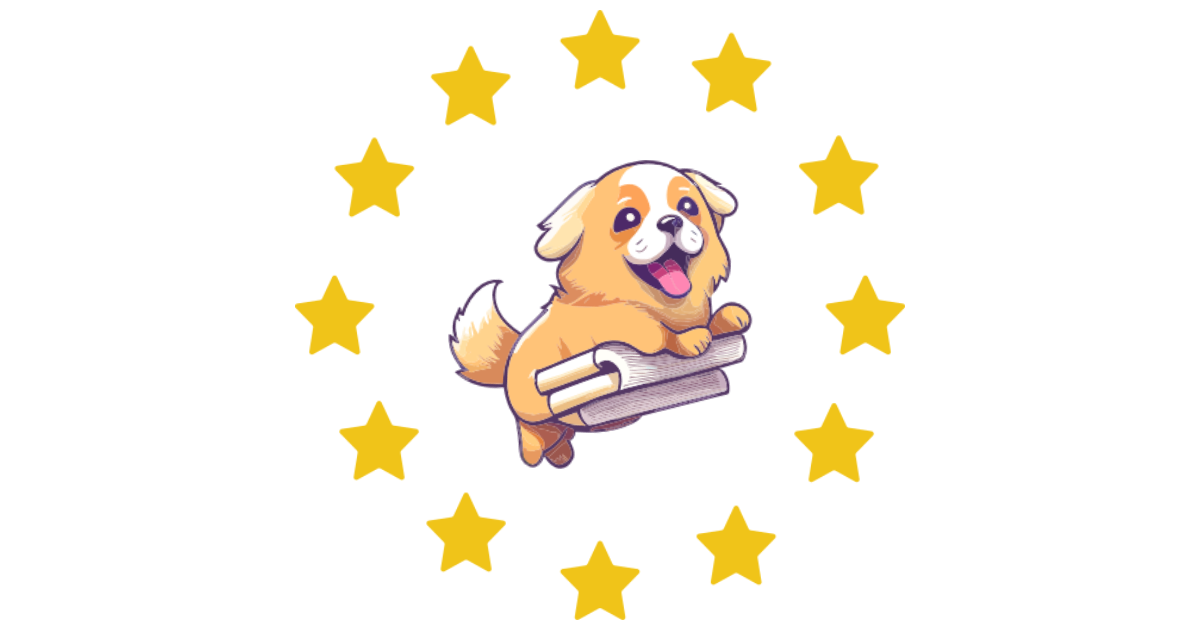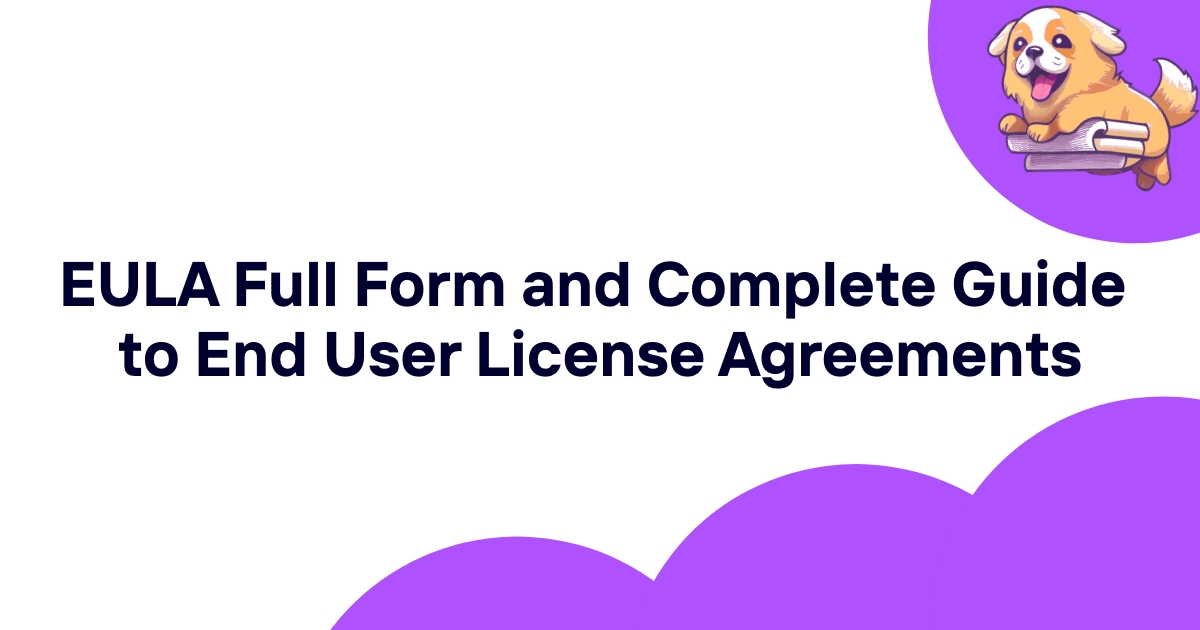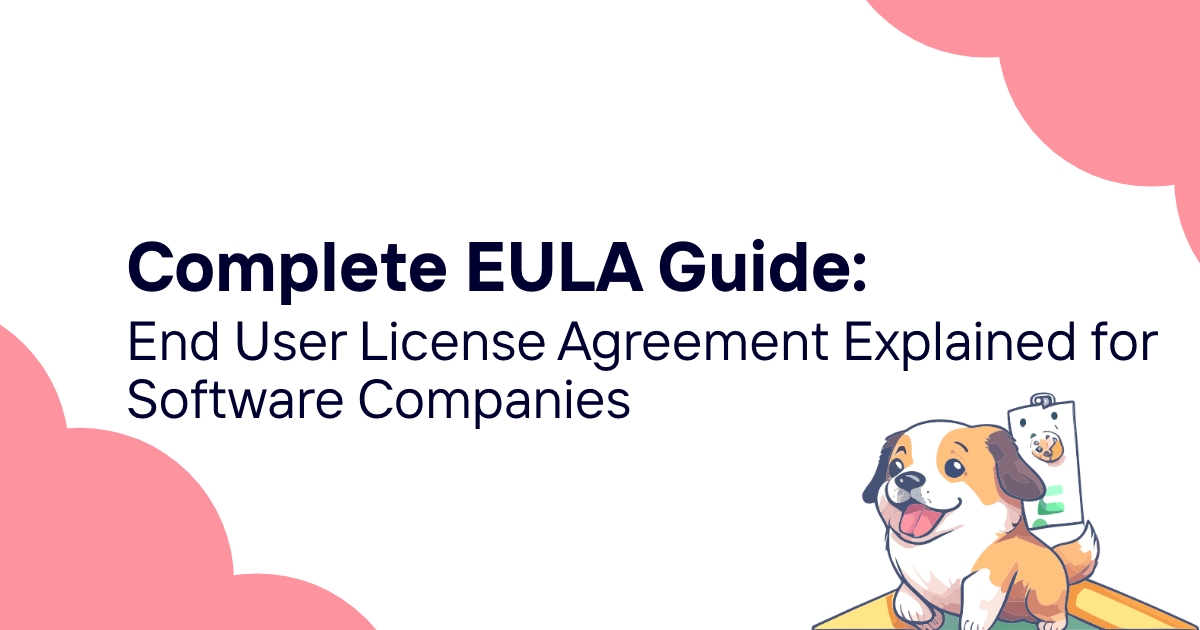Software users encounter EULAs regularly, but many people don't understand what these agreements actually do or why they matter. Whether you're a software developer creating your first product or a business leader trying to understand licensing requirements, knowing what an EULA is and how it works is essential for modern software operations.
This guide explains EULAs in simple terms, covering everything from basic definitions to practical implementation strategies. By the end, you'll understand exactly what EULAs accomplish and whether your software needs one.
What is an EULA? Basic Definition and Purpose
An EULA (End User License Agreement) is a legal contract between a software company and the person using their software. Think of it as a set of rules that explains what users can and cannot do with a software product after they download, install, or purchase it.
The Basic EULA Concept
At its core, an EULA establishes a licensing relationship rather than a sale:
Not a Purchase: When someone "buys" software, they're actually purchasing a license to use it under specific conditions, not ownership of the software itself.
Permission to Use: The EULA grants permission to use the software while maintaining the developer's ownership of the underlying code and intellectual property.
Rule Setting: EULAs establish clear boundaries about acceptable use, helping prevent misunderstandings between software companies and users.
Legal Protection: These agreements provide legal frameworks for protecting software companies from liability and unauthorized use.
Why EULAs Matter for Everyone
EULAs affect both software companies and users in important ways:
For Software Companies: EULAs protect intellectual property, limit liability, and establish clear usage guidelines that prevent costly disputes.
For Users: EULAs clarify what they can do with software, what support they can expect, and what happens if something goes wrong.
For Businesses: Organizations using software need to understand EULA terms to ensure compliance and avoid legal issues.
For Developers: Even individual developers benefit from EULAs that protect their work and establish professional relationships with users.
Common EULA Scenarios
People encounter EULAs in various situations throughout their digital lives:
Software Installation: Most desktop applications require EULA acceptance before installation can proceed.
Mobile App Downloads: App stores typically require developers to include EULAs for applications that collect data or include paid features.
Online Services: Web-based software often presents EULAs during account creation or first-time access.
Business Software: Enterprise applications usually include comprehensive EULAs that address organizational use and administrative controls.
EULA vs Regular Contracts
EULAs differ from typical contracts in several important ways:
Mass Distribution: EULAs are designed for standardized acceptance by many users rather than individual negotiation.
Clickthrough Acceptance: Most EULAs use simplified acceptance mechanisms like clicking "I agree" buttons rather than formal signatures.
Intellectual Property Focus: EULAs emphasize protecting software intellectual property more than typical service contracts.
Technical Integration: EULAs often integrate directly with software installation and operation processes.
Why Software Companies Need EULAs
Software companies face unique legal and business challenges that make EULAs essential tools for protecting their interests and maintaining sustainable business operations.
Intellectual Property Protection
Software represents valuable intellectual property that requires legal protection:
Code Protection: Software source code contains proprietary algorithms, business logic, and technical innovations that competitors could steal without proper legal protection.
Algorithm Security: Many software products include valuable algorithms or processes that provide competitive advantages requiring protection from reverse engineering.
Brand Protection: Software companies invest significantly in building brand recognition and reputation that EULAs help protect from unauthorized use.
Trade Secret Preservation: Proprietary software often contains trade secrets that lose their value if disclosed or copied without authorization.
Liability Management and Risk Reduction
EULAs help software companies manage various types of legal and financial risks:
Performance Disclaimers: Software doesn't always work perfectly, and EULAs help manage user expectations while limiting company liability for minor issues.
Use Case Limitations: EULAs clarify that software is designed for specific purposes and help prevent liability for inappropriate or unauthorized uses.
Data Protection: Software that handles user data needs clear agreements about data handling responsibilities and liability allocation.
Security Incident Protection: EULAs help manage liability when security incidents affect user data or system availability.
Business Model Support
Modern software business models rely on licensing frameworks that EULAs provide:
Subscription Services: Software-as-a-Service offerings require clear agreements about service availability, user rights, and payment obligations.
Feature Restrictions: Many software companies offer different tiers of functionality that require license agreements to enforce usage restrictions.
Usage Monitoring: Business models based on usage metrics require agreements that permit monitoring and billing based on actual consumption.
Geographic Restrictions: Some software companies need to restrict usage in certain countries due to legal requirements or business strategies.
Competitive Advantage Preservation
EULAs help software companies maintain competitive positions:
Feature Protection: Unique software features represent competitive advantages that require legal protection from copying or reverse engineering.
Customer Relationship Control: EULAs establish direct relationships with end users even when software is distributed through intermediaries.
Market Position Defense: Strong intellectual property protections help software companies defend market positions against competitors.
Innovation Investment Protection: Companies invest heavily in software development and need legal frameworks to protect those investments.
How EULAs Protect Software Developers
EULAs provide multiple layers of protection that help software developers build sustainable businesses while maintaining control over their creations.
Copyright and Intellectual Property Rights
EULAs work with copyright law to provide comprehensive intellectual property protection:
Automatic Copyright Protection: Software code receives automatic copyright protection when created, but EULAs help enforce those rights through clear usage restrictions.
License Grant Limitations: EULAs specify exactly what rights users receive, preventing claims that users have broader permissions than intended.
Modification Restrictions: Most EULAs prohibit users from modifying software code, protecting developers from unauthorized changes that could affect functionality or security.
Distribution Control: EULAs prevent users from redistributing software without authorization, helping developers maintain control over distribution channels and pricing.
Reverse Engineering and Competitive Protection
EULAs include specific provisions designed to protect against competitive threats:
Reverse Engineering Prohibitions: Most EULAs explicitly prohibit reverse engineering, decompilation, or disassembly of software code.
Algorithm Protection: EULAs help protect proprietary algorithms and business logic from analysis and copying by competitors.
Interface Protection: Software interfaces and user experience designs receive protection through EULA restrictions on copying or mimicking.
Data Mining Restrictions: EULAs often prohibit automated data extraction or analysis that could reveal competitive information.
Financial and Legal Risk Management
EULAs help developers manage various types of business risks:
Warranty Limitations: Software development involves complexity that makes perfect performance impossible, so EULAs include reasonable warranty disclaimers.
Liability Caps: EULAs typically limit developer liability for software-related damages to reasonable amounts that don't threaten business viability.
Use Case Clarification: Clear usage guidelines help prevent liability for inappropriate software applications or user misuse.
Indemnification Protection: Some EULAs include provisions protecting developers from liability for user actions or unauthorized modifications.
Revenue Model Protection
EULAs support various monetization strategies that depend on usage control:
License Compliance: EULAs establish legal frameworks for monitoring and enforcing license compliance, supporting revenue collection.
Upgrade Pathways: License agreements create clear distinction between different software versions and feature sets that support tiered pricing.
Subscription Enforcement: Software-as-a-Service models require agreements that support subscription billing and service termination procedures.
Usage Tracking: Some business models require usage monitoring for billing purposes, which EULAs can authorize when implemented appropriately.
As detailed in our EULA full form guide, understanding the complete legal framework helps developers create more effective protection strategies.
EULA vs Terms of Service Comparison
Many people confuse EULAs with Terms of Service, but these documents serve different purposes and protect different aspects of software businesses.
Primary Purpose Differences
EULAs and Terms of Service address distinct aspects of user relationships:
EULA Focus: End User License Agreements specifically govern how users can interact with software products, including installation, operation, and modification restrictions.
Terms of Service Focus: Terms of Service typically govern website usage, account management, and online service interactions rather than software product licensing.
Intellectual Property Emphasis: EULAs heavily emphasize protecting software intellectual property, while Terms of Service focus more on service availability and user behavior.
Usage Scope: EULAs typically apply to software installed on user devices, while Terms of Service apply to web-based interactions and account relationships.
Content and Structure Differences
The content of EULAs and Terms of Service reflects their different purposes:
Technical Restrictions: EULAs include detailed technical restrictions about software modification, reverse engineering, and redistribution that aren't relevant for service agreements.
License Grants: EULAs specify exact permissions for software use, while Terms of Service establish service access rights and usage guidelines.
Liability Provisions: EULAs focus on software performance and intellectual property liability, while Terms of Service address service availability and user conduct.
Duration and Termination: EULAs often remain in effect for the life of software installations, while Terms of Service may change more frequently with service updates.
When to Use Each Document
Understanding when each document type is appropriate helps ensure proper legal coverage:
EULA Applications: Use EULAs for downloadable software, mobile applications, desktop programs, and any situation where users install or run software locally.
Terms of Service Applications: Use Terms of Service for websites, online accounts, cloud-based services, and web application access.
Combined Approaches: Many software companies need both documents – EULAs for their software products and Terms of Service for their websites and online services.
Integration Considerations: When using both documents, ensure they complement each other without creating conflicting requirements or confusing users.
Legal and Practical Implications
The choice between EULAs and Terms of Service affects legal protection and user experience:
Enforcement Mechanisms: EULAs often integrate directly with software installation processes, while Terms of Service typically require separate acceptance mechanisms.
Update Procedures: Software updates can automatically present revised EULAs, while Terms of Service updates typically require separate notification and acceptance processes.
User Expectations: Users expect different types of information from EULAs versus Terms of Service, affecting how content should be organized and presented.
Regulatory Compliance: Some regulations apply specifically to software licensing or online services, requiring different compliance approaches.
Common EULA Terms and Clauses
Understanding standard EULA components helps both developers and users know what to expect from these agreements and how they typically work.
License Grant and Permissions
The license grant section forms the core of every EULA by defining what users can do:
Installation Rights: Specific permissions for installing software on devices, including any limitations on the number of installations or concurrent users.
Usage Scope: Clear definition of permitted software uses, distinguishing between personal, commercial, educational, or other use categories.
Feature Access: Specification of which software features are available under the license and any restrictions on advanced functionality.
Geographic Permissions: Any territorial limitations on where the software can be used or accessed.
Duration Terms: Whether the license is perpetual, subscription-based, or limited to specific time periods.
Restrictions and Prohibitions
EULAs typically include various restrictions designed to protect software intellectual property:
Modification Prohibitions: Restrictions against altering software code, appearance, or functionality without explicit permission.
Reverse Engineering Limits: Prohibitions against decompiling, disassembling, or analyzing software to understand its internal workings.
Distribution Restrictions: Rules preventing users from sharing, selling, or redistributing software to other parties.
Commercial Use Limitations: Distinctions between personal and commercial use with appropriate restrictions for business applications.
Competitive Use Prohibitions: Restrictions against using software to develop competing products or analyze competitive strategies.
Intellectual Property Protection
Strong intellectual property clauses protect developer rights and investments:
Ownership Declarations: Clear statements that developers retain ownership of all software intellectual property including code, algorithms, and designs.
Copyright Requirements: Obligations to maintain copyright notices and intellectual property attributions when using or displaying software.
Trademark Protections: Rules governing use of company names, logos, and trademarks in connection with software usage.
Trade Secret Confidentiality: Requirements to maintain confidentiality of proprietary software components and business logic.
Warranty and Support Provisions
EULAs establish realistic expectations about software performance and available support:
Performance Disclaimers: Clear statements about what level of performance users can expect and what issues are considered normal.
Support Limitations: Specification of what technical support is provided and what issues are covered under different support tiers.
Update Policies: Information about software updates, including whether they're provided free or require additional payments.
Compatibility Warnings: Disclaimers about software compatibility with different hardware, operating systems, or other software products.
EULA Examples from Popular Software
Examining real-world EULAs helps illustrate how different companies approach licensing and what strategies work for different types of software products.
Microsoft Office EULA Approach
Microsoft's EULA demonstrates comprehensive enterprise software licensing:
Multi-Use Scenarios: The agreement addresses both personal and business use with clear distinctions and appropriate restrictions for each context.
Cloud Integration: Modern Microsoft EULAs address cloud service integration and data synchronization across multiple devices and platforms.
Subscription Model Support: The agreement supports both traditional perpetual licensing and modern subscription-based access models.
Enterprise Features: Special provisions address enterprise deployment, administrative controls, and organizational compliance requirements.
Adobe Creative Suite Licensing
Adobe's approach shows how subscription-based creative software handles licensing:
Creative Work Ownership: Clear separation between software licensing and ownership of creative works produced using the software.
Subscription Enforcement: Detailed provisions for subscription management, including what happens when subscriptions expire or are cancelled.
Cloud Storage Integration: Terms addressing cloud storage for creative assets and collaboration features.
Professional Use Support: Licensing terms that explicitly support professional creative work and commercial applications.
Mobile App Store EULAs
App store EULAs demonstrate simplified licensing for consumer applications:
Simplified Language: Mobile app EULAs typically use more accessible language appropriate for general consumer audiences.
Platform Integration: Terms that address app store distribution and platform-specific features and limitations.
Data Collection Transparency: Clear information about data collection practices required by app store policies and privacy regulations.
Update Mechanisms: Streamlined procedures for pushing updates and revised terms through app store distribution channels.
Open Source License Integration
Some commercial software includes open source components requiring special consideration:
License Compatibility: Careful coordination between commercial EULAs and open source license requirements to avoid conflicts.
Attribution Requirements: Proper acknowledgment of open source components and their respective license terms.
Distribution Compliance: Ensuring commercial distribution complies with both commercial EULA terms and open source license obligations.
Source Code Availability: Clear information about which software components are available as source code and under what terms.
As discussed in our cookie checker tool guide, software companies often need to coordinate multiple types of legal documentation to address different aspects of their products and services.
Legal Enforceability of EULAs
Understanding what makes EULAs legally enforceable helps both developers and users know their rights and obligations under these agreements.
Requirements for Valid Contracts
EULAs must meet basic contract law requirements to be legally enforceable:
Offer and Acceptance: Software companies must clearly present license terms, and users must have meaningful opportunities to accept or reject them.
Consideration: There must be value exchanged between parties – typically software access in exchange for compliance with license terms.
Legal Capacity: Users must have legal authority to enter binding agreements, which creates special considerations for minors or organizational representatives.
Mutual Assent: Both parties must understand and agree to the essential terms of the licensing relationship.
Common Enforceability Challenges
Several factors can undermine EULA enforceability in legal proceedings:
Inadequate Notice: EULAs presented after purchase or in ways that don't provide reasonable review opportunities may face enforceability challenges.
Unconscionable Terms: Extremely one-sided provisions or unreasonable restrictions may be deemed unenforceable by courts.
Procedural Problems: Issues with the acceptance process, including confusing interfaces or misleading presentation, can affect enforceability.
Conflicting Laws: Consumer protection laws or other regulations may override certain EULA provisions in specific jurisdictions.
International Considerations
Global software distribution creates complex legal enforcement issues:
Governing Law Selection: Choice of law provisions must be reasonable and enforceable in relevant jurisdictions where software is used.
Consumer Protection Variations: Different countries have varying consumer protection laws that may limit certain types of EULA provisions.
Cultural and Legal Differences: Legal concepts and enforcement practices vary significantly between different legal systems and cultural contexts.
Translation Requirements: Some jurisdictions require local language translations for contracts to be fully enforceable.
Best Practices for Strong Enforcement
Several strategies enhance EULA legal effectiveness and enforceability:
Clear Presentation: Present EULAs in easily accessible formats with reasonable opportunities for review before acceptance.
Reasonable Terms: Include only necessary restrictions and avoid overly broad or punitive provisions that courts might reject.
Professional Legal Review: Have qualified attorneys review EULAs for enforceability issues and compliance with applicable laws.
Consistent Application: Apply EULA terms consistently across all users and situations to demonstrate good faith enforcement.
Documentation: Maintain records of user acceptance and EULA versions for potential legal proceedings.
Creating Your First EULA
Developing an effective EULA requires understanding legal requirements, business objectives, and user experience considerations that affect both protection and adoption.
Planning and Requirements Gathering
Successful EULA development starts with comprehensive planning:
Business Model Analysis: Understand how your software business model affects licensing requirements and user relationships.
Risk Assessment: Identify specific risks your EULA needs to address, including intellectual property threats, liability concerns, and compliance requirements.
User Research: Consider your target users and their expectations about software licensing and usage rights.
Technical Considerations: Understand how your software works and what technical restrictions or permissions are necessary.
Legal Consultation: Engage qualified attorneys early in the process to ensure compliance with applicable laws and regulations.
Content Development Strategy
Effective EULAs balance comprehensive protection with user-friendly communication:
Essential Elements: Include all legally required components while avoiding unnecessary complexity that confuses users or creates enforcement problems.
Clear Language: Use plain English whenever possible to enhance user understanding and reduce confusion about rights and obligations.
Logical Organization: Structure content in logical order that matches user concerns and typical usage patterns.
Practical Examples: Include specific examples that help users understand how abstract legal concepts apply to real-world situations.
Regular Updates: Plan for ongoing EULA maintenance and updates as your business evolves and legal requirements change.
Implementation and Integration
Successful EULA deployment requires careful attention to user experience and technical integration:
Acceptance Mechanisms: Choose appropriate methods for obtaining user agreement that balance legal effectiveness with user convenience.
Presentation Timing: Present EULAs at appropriate points in user workflows that allow meaningful review without disrupting essential processes.
Storage and Access: Provide easy ways for users to access EULA terms after initial acceptance for future reference.
Change Management: Establish clear procedures for updating EULA terms and notifying users of changes.
Support Integration: Train customer support staff to answer common questions about EULA terms and help users understand their rights and obligations.
Monitoring and Optimization
Ongoing EULA management ensures continued effectiveness and legal protection:
Performance Tracking: Monitor how EULA presentation affects user acceptance rates and overall conversion metrics.
Legal Effectiveness: Evaluate how well your EULA supports business protection and addresses identified risks.
User Feedback: Collect and analyze user questions and concerns about EULA terms to identify areas needing clarification.
Compliance Monitoring: Track user compliance with license restrictions and identify common violation patterns that might require additional education or enforcement.
Regular Reviews: Conduct periodic reviews to ensure EULAs remain current with business practices, legal requirements, and industry standards.
Building effective EULAs requires combining legal expertise with practical business considerations and user experience design. The most successful agreements provide strong legal protection while supporting positive user relationships and business growth.
For software companies looking to implement comprehensive legal documentation as part of broader compliance strategies, integrated approaches offer significant advantages over managing EULAs in isolation from other business processes and user management systems.
Ready to create effective legal documentation that protects your software while supporting user relationships? Use ComplyDog and get comprehensive legal documentation support, integrated user agreement management, and complete compliance framework tools that scale with your software business.
